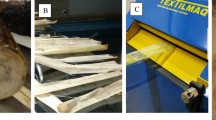Abstract
The effect of vinyltrimethoxysilane- and γ-aminopropyltriethoxysilane-treated nanosilica and untreated nanosilica particles as fillers on practical properties of urea formaldehyde-bonded plywood was evaluated. Nanosilica used in two different contents (1 and 2 %). The results of FT-IR spectroscopy revealed that both silane coupling agents can well treat the nanosilica particles. The least water absorbtion and thickness swelling observed in the case of boards with 1 % treated nanosilica with vinyltrimethoxysilane, and those with γ-aminopropyltriethoxysilane had the best bending strength and modulus of elasticity. The higher shear strength found for boards with 2 % treated nanosilica by 1 % vinyltrimethoxysilane. Overall, in comparison with the common filler used in plywood production, namely wheat flour, nanofillers had a greater improving effect on the plywood properties. The effect of vinyl silane and amino silane on properties of plywood is different with each other because of their different constructions. The vinyl silane had a better performance than the amino one to improve the physical properties (2 and 24 h water absorption and thickness swelling) and shear strength of the produced boards but the latter showed a higher increasing impact on the modulus of elasticity and rupture. The results showed that 1 % nanosilica had proper enough effect on properties of plywood panels and even in some cases had better effect than 2 % nanosilica content.






Similar content being viewed by others

References
ASTM D 3043-00 (2000) Standard test methods for structural panels in flexure. Vol. 04. 10, West Conshohocken, PA, USA
Caffery EL (1970) Laboratory preparation for macromolecular chemistry. McGraw-Hill, New York
Doosthoseini K, Zarea-hosseinabadi H (2010) Using Na MMT nano clay as secondary filler in plywood manufacturing. J Indian Acad Wood Sci 7(1–2):58–64. doi:10.1007/s13196-011-0012-9
Eberhardt T, Reed L, Karen G (2006) Strategies for improving the performance of plywood adhesive mix fillers from southern yellow pine bark. For Prod J 56(10):64–68
Hertel W (1968) Mechanism of gaseous siloxane reaction with silica. I. J Phys Chem 72:1248–1253
ISO 12466-1 (2007) Plywood-bonding quality—Part 1: test methods, 2nd edn. ISO International organization for standardization, Switzerland
ISO 16983 (2003) Wood-based panels-determination of swelling in thickness after immersion in water, 1st edn. CEN, Brussels
Jinshu S, Jianzhang L, Wenrui Z, Derong Z (2007) Improvement of wood properties by urea formaldehyde resin and nano Sio2. Front For China 2(1):104–109. doi:10.1007/s.11461-007-0017-0
Kinloch AJ, Young RJ (1983) Fracture behavior of polymer. Applied Science Publishers, London
Lei H, Du G, Pizzi A, Celzard A (2008) Influence of nanoclay on urea-formaldehyde resins for wood adhesives and its model. J Appl Polym Sci 109:2442–2451
Lie W, Deng YH, Zhou M, Xuan L, Feng Q (2006) Mechanical properties of nano SiO2 filled gypsum particle board. Project (30371130) Supported by the National Natural Science Foundation of China Advanced material science and technology 16: 360–364. doi: 10.1016/S1003-6326(06)60210-0
Oh YS, Sellers JRT, Kimm MG (1997) Fillers for plywood adhesives made from acid hydrolysis of municipal newsprint wastes. For Prod J 47(10):107–110
Plueddemann EP (1991) Silane coupling agents, 2nd edn. Plenum, New York and London
Qiaojia L, Guidi Y, Jinghong L, Jiuping R (2006) Property of nano SiO2/urea formaldehyde resin. Front For China 2:230–237
Rider AN, Arnott DR (2000) Boiling water and silane pretreatment of aluminum alloys for durable adhesive bonding. Int J Adhes Adhes 20:200–209
Saltiel C, Chen Q, Manickavasagam S, Schadler LS, Siegel RW, Menguc MP (2004) Identification of the dispersion behavior of surface treated nanoscale powders. J Nanopart Res 6(6):35–46
Torrey KS, Yrjana WA, King JA (2003) Effect of thermally conductive fillers on the internal bond strength of strand board. For Prod J 53(11):74–80
Xie Y, Hill C, Xiao Z, Militz H, Mai C (2010) Silane coupling agents used for natural fiber/polymer composites. A review. J Compos Part A 41(7):806–819
Yang GD, Lin QJ, Liu JH (2004) The effects of nano-SiO2 on the properties of the urea formaldehyde resin. J Fujian For Coll 24(2):114–117
Zou W, Peng J, Zhang L, Liao B, Xiao F (2006) Effect of nanosilica on the performance of poly (MMA/BA/MMA). J Mater Lett 16:725–729
Author information
Authors and Affiliations
Corresponding author
Rights and permissions
About this article
Cite this article
Moezzipour, B., Doosthoseini, K., Faezipour, M.M. et al. The effect of different kinds of nanosilica on practical properties of plywood. J Indian Acad Wood Sci 10, 118–124 (2013). https://doi.org/10.1007/s13196-013-0104-9
Received:
Accepted:
Published:
Issue Date:
DOI: https://doi.org/10.1007/s13196-013-0104-9



